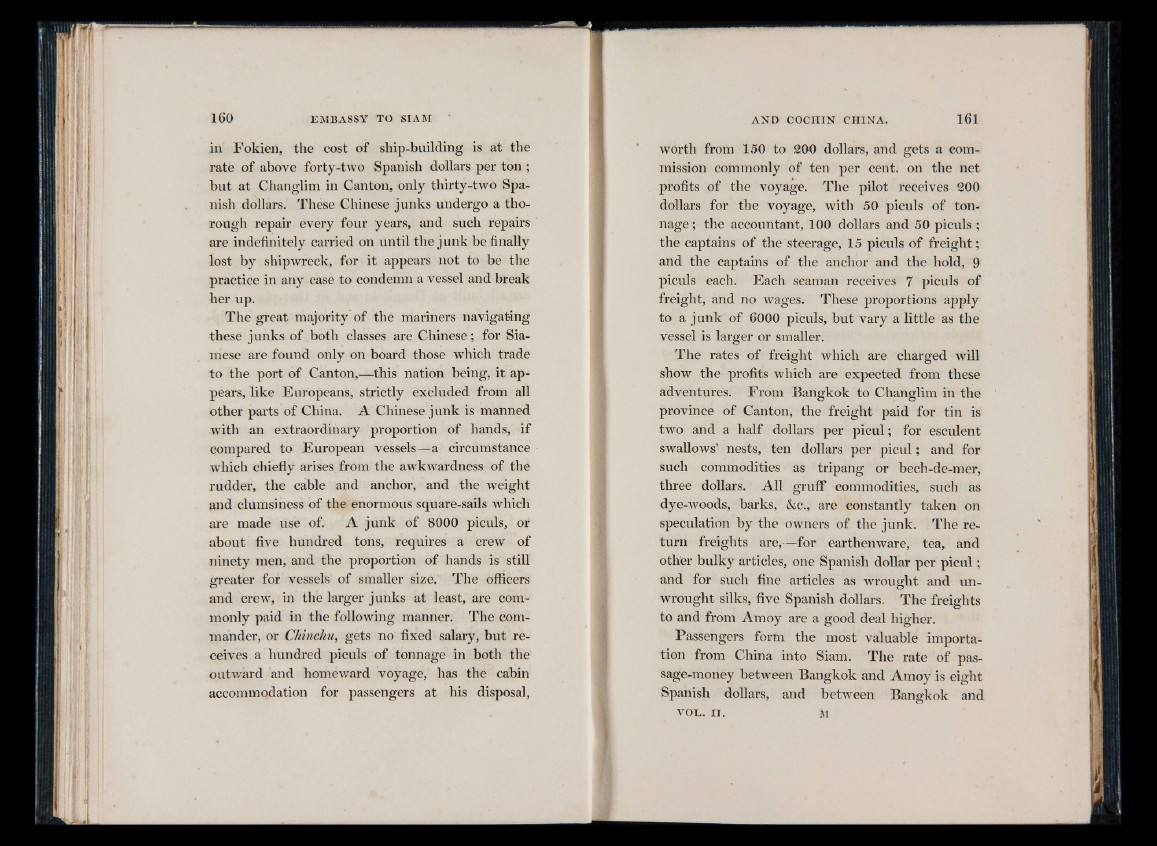
in Fokien, the cost of ship-building is at the
rate of above forty-two Spanish dollars per ton ;
but at Changlim in Canton, only thirty-two Spanish
dollars. These Chinese junks undergo a thorough
repair every four years, and such repairs
are indefinitely carried on until the junk be finally
lost by shipwreck, for it appears not to be the
practice in any case to condemn a vessel and break
her up.
The great majority of the mariners navigating
these junks of both classes are Chinese; for Siamese
are found only on board those which trade
to the port of Canton,—this nation being, it appears,
like Europeans, strictly excluded from all
other parts of China. A Chinese junk is manned
with an extraordinary proportion of hands, if
compared to European vessels—a circumstance
which chiefly arises from the awrkwardness of the
rudder, the cable and anchor, and the weight
and clumsiness of the enormous square-sails which
are made use of. A junk of 8000 piculs, or
about five hundred tons, requires a crew of
ninety men, and the proportion of hands is still
greater for vessels of smaller size. The officers Oa
nd crew, in the larger junks at least, are commonly
paid in the following manner. The commander,
or Chinchu, gets no fixed salary, but receives
a hundred piculs of tonnage in both the
outward and homeward voyage, has the cabin
accommodation for passengers at his disposal,
worth from 150 to 200 dollars, and gets a commission
commonly of ten per cent, on the net
profits of the voyage. The pilot receives 200
dollars for the voyage, with 50 piculs of tonnage
; the accountant, 100 dollars and 50 piculs ;
the captains of the steerage, 15 piculs of freight;
and the captains of the anchor and the hold, 9
piculs each. Each seaman receives 7 piculs of
freight, and no wages. These proportions apply
to a junk of 6000 piculs, but vary a little as the
vessel is larger or smaller.
The rates of freight which are charged will
show the profits which are expected from these
adventures. From Bangkok to Changlim in the
province of Canton, the freight paid for tin is
two and a half dollars per picul; for esculent
swallows’ nests, ten dollars per picul; and for
such commodities as tripang or bech-de-mer,
three dollars. All gruff commodities, such as
dye-woods, barks, &c., are constantly taken on
speculation by the owners of the junk. The return
freights are,—for earthenware, tea, and
other bulky articles, one Spanish dollar per picu l;
and for such fine articles as wrought and unwrought
silks, five Spanish dollars. The freights
to and from Amoy are a good deal higher.
Passengers form the most valuable importation
from China into Siam. The rate of pas-
sage-money between Bangkok and Amoy is eight
Spanish dollars, and between Bangkok and
VOL. I I . m